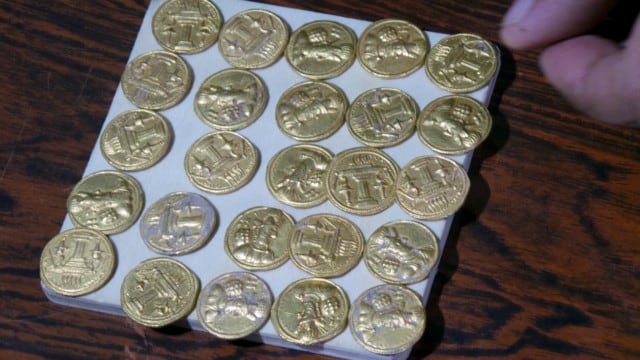
30.12.2012 Ancient gold coins
Categories: Minting - Numismatics , Calendar , Nálezy nejenom s detektorem na blízkém východě

Archaeologists rejoiced at the excellent discovery in late December 2012. In Iraq's Wasit province, they unearthed 66 gold coins that are at least 1,400 years old.
They reported this almost as soon as they discovered the depot. From the start, the archaeologists were keen for the coins to be displayed in Baghdad's National Museum in the future.
The coins date back to the so-called Sasanian Empire, the centre of whichwas located in Iraq and Iran over an area of some 6,600 square kilometres. It existed from the third to the seventh century AD. The archaeologists sent the coins to laboratories where they were thoroughly analysed. They needed definitive proof that the gold coins were genuine.
The archaeologists discovered the coins in the city of Al-Aziziyah, located 70 kilometres southeast of Baghdad in Wasit province. This was reported by Hassanian Mohammed Ali, who is the head of the local Department of Antiquities and Antiquities. The coins apparently depict a king or god with flames.
Many of Iraq's archaeological sites have been vandalized and hit in recent decades. This was particularly the case after the 2003 US invasion. The National Museum in the capital Baghdad has also been looted. Twelve thousand archaeological sites were destroyed during that time, from which 32,000 objects disappeared and 15,000 others were stolen from the museum. Thousands more artefacts disappeared during illegal excavations in more remote locations.
A ritual site
This year, archaeologists in the city of Grisu in southern Iraq found a site where rituals are believed to have taken place. The discovery was made by a team led by Sebastien Rey of the British Museum and Tina Greenfield of the University of Saskatchewan. They came across the remains of animals such as sheep, cows, deer, gazelles, fish, goats, pigs and bird bones. As well as more than 300 broken ceramic cups, bowls and other vessels.
It's basically a ritual pit with a scorched floor and a thick layer of ash. According to ancient texts, twice a year, the area would hold rituals and feasts in honour of the Mesopotamian god Ningirsu. Experts say this pit may have been used for that purpose. Pottery vessels were used for drinking and eating before being thrown into the pit.
Sources: www.archaeology.org, https://gulfnews.com/
The article is included in categories:



